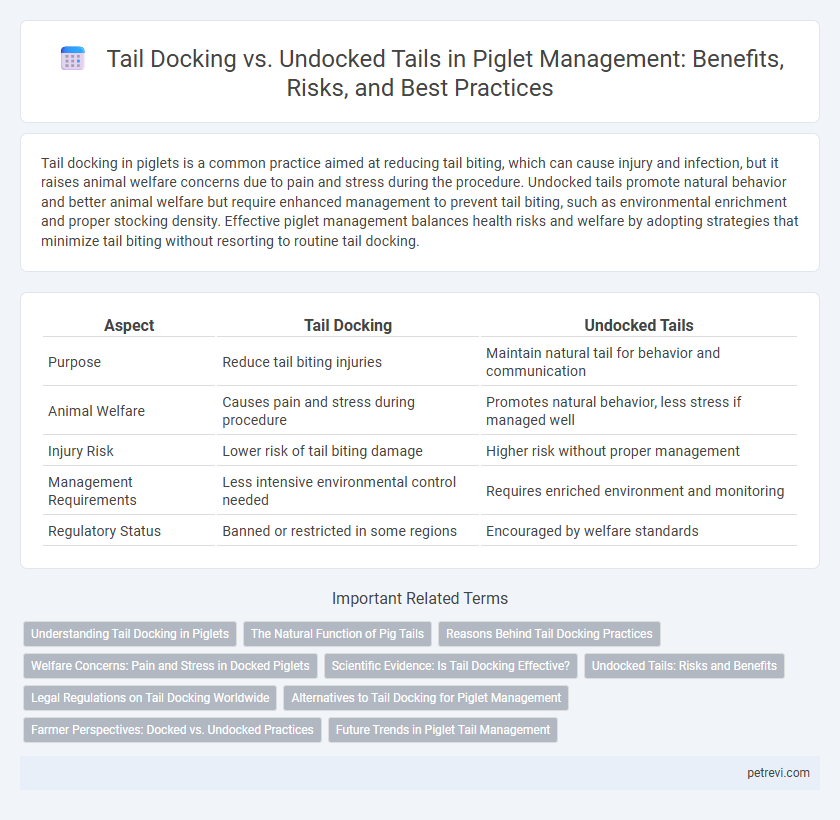Tail docking in piglets is a common practice aimed at reducing tail biting, which can cause injury and infection, but it raises animal welfare concerns due to pain and stress during the procedure. Undocked tails promote natural behavior and better animal welfare but require enhanced management to prevent tail biting, such as environmental enrichment and proper stocking density. Effective piglet management balances health risks and welfare by adopting strategies that minimize tail biting without resorting to routine tail docking.
Table of Comparison
| Aspect | Tail Docking | Undocked Tails |
|---|---|---|
| Purpose | Reduce tail biting injuries | Maintain natural tail for behavior and communication |
| Animal Welfare | Causes pain and stress during procedure | Promotes natural behavior, less stress if managed well |
| Injury Risk | Lower risk of tail biting damage | Higher risk without proper management |
| Management Requirements | Less intensive environmental control needed | Requires enriched environment and monitoring |
| Regulatory Status | Banned or restricted in some regions | Encouraged by welfare standards |
Understanding Tail Docking in Piglets
Tail docking in piglets is a common management practice aimed at reducing tail biting, a behavior that can cause injury and infection in swine herds. Research indicates that undocked tails may increase the risk of tail biting, which can lead to economic losses due to decreased growth performance and increased veterinary costs. Proper environmental enrichment and management strategies are essential to minimize tail biting in piglets with undocked tails, promoting welfare without the need for tail docking.
The Natural Function of Pig Tails
Pig tails serve a crucial role in communication and balance, signaling social status and emotional states among piglets. Undocked tails help maintain natural behaviors and reduce stress by allowing piglets to express discomfort or contentment through tail posture. Tail docking, commonly performed to prevent tail biting, disrupts these natural functions and may increase stress and behavioral problems in piglets.
Reasons Behind Tail Docking Practices
Tail docking in piglets is primarily performed to reduce the risk of tail biting, a harmful behavior that can lead to infections, injuries, and poor welfare. This preventive measure is often adopted in intensive pig farming systems where high stocking densities increase stress and aggression among pigs. However, undocked tails are preferred in free-range or well-managed environments with enriched housing that minimize stress and natural behaviors, thereby reducing the incidence of tail biting.
Welfare Concerns: Pain and Stress in Docked Piglets
Tail docking in piglets involves the removal of part of the tail to prevent tail biting but causes acute pain and stress during the procedure, raising significant animal welfare concerns. Studies show elevated cortisol levels and vocalizations in docked piglets, indicating distress, while the absence of pain mitigation exacerbates these effects. Undocked piglets avoid this immediate pain, although alternative management strategies are necessary to address tail biting risks and ensure overall welfare.
Scientific Evidence: Is Tail Docking Effective?
Scientific evidence indicates that tail docking reduces the incidence of tail biting among piglets, improving welfare by minimizing injury and infection. However, undocked piglets raised in enriched, stress-free environments demonstrate lower tail biting behavior, suggesting management practices significantly influence outcomes. Research emphasizes that tail docking alone is not a comprehensive solution; environmental enrichment and proper husbandry are critical for effective tail biting prevention.
Undocked Tails: Risks and Benefits
Undocked tails in piglets reduce the risk of tail docking-related pain and infections, promoting natural behavior and welfare. However, undocked tails increase the risk of tail biting, which can lead to injuries, infections, and reduced growth performance, requiring effective management strategies. Proper environmental enrichment and monitoring are essential to minimize tail biting incidents in pigs with undocked tails.
Legal Regulations on Tail Docking Worldwide
Legal regulations on tail docking in piglet management vary significantly worldwide, with the European Union imposing strict restrictions that generally prohibit routine tail docking except under veterinary advice to prevent tail biting. In contrast, countries like the United States and Canada allow tail docking more liberally, often considering it a standard practice to reduce injury risks in intensive farming systems. Compliance with these regulations impacts farm management practices, animal welfare standards, and international trade considerations in the swine industry.
Alternatives to Tail Docking for Piglet Management
Alternatives to tail docking in piglet management include enhanced environmental enrichment, improved hygiene, and selective breeding for reduced tail biting behavior. Enrichment strategies such as providing straw, toys, or foraging materials help reduce stress and redirect piglets' natural biting tendencies. Proper stocking density and consistent monitoring further minimize tail biting incidents, promoting animal welfare without the need for tail docking.
Farmer Perspectives: Docked vs. Undocked Practices
Farmers with docked piglets often report easier management due to reduced tail biting incidents, which minimizes injury and infection risks and improves overall herd health. Conversely, those adopting undocked practices emphasize animal welfare and note increased vigilance and environmental enrichment as essential strategies to prevent tail biting and stress. The decision between docked and undocked tails reflects a balance between operational efficiency and ethical considerations, influencing farm protocols and piglet welfare outcomes.
Future Trends in Piglet Tail Management
Future trends in piglet tail management emphasize alternatives to tail docking, such as enhanced environmental enrichment and improved sow housing systems to reduce tail-biting behaviors. Genetic selection for less aggressive piglets and precision livestock farming technologies, including real-time monitoring of piglet welfare, are gaining traction as sustainable solutions. Regulatory shifts in the EU and increased consumer demand for welfare-friendly pork products further drive adoption of undocked tail practices in pig production.
Tail docking vs Undocked tails for Piglet management Infographic

 petrevi.com
petrevi.com